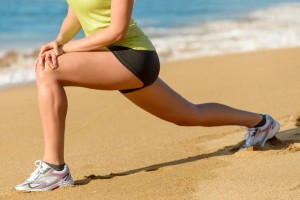Posted on October 18, 2016 by Jenny Cromack
Static stretching is often reserved for the end of a session, and don’t worry if this is what you are doing you are not doing anything wrong. Occasionally though, static stretching does have it’s place at the start of a workout or indeed as part of a ‘rehab’ home based static stretching programme , particularly when a muscle has been identified as a limiting factor of a movement. I will use the example that most people suffer with…. tight hamstrings. In this instance a regular static stretching program can be extremely effective. Below is a 4 stage model to progress over a number of weeks. Like exercises, stretches are only as good as long as we are adapting to them.
Phase 1. Banded Distraction Stretches: This often sounds more complicated that it is. Using a resistance band applied around a static object and the muscle being stretched can manipulate the joint and assist in correct movement across joint surfaces. A useful time to use this technique is when a sensation of blocking, or complete restriction of an range that should be achievable.
Phase 2. Contract-Relax: For you that have trained with Motive8 North, you will likely be all too familiar with this method. it is commonly referred to as PNF stretching, or proprioceptive neuromuscular facilitation if you like long words. Simply put by stretching a muscle to its current end range, applying 5-7 seconds of concentric muscle action, provides feedback to the body to relax following contraction, allowing greater ranges of motion to be achieved…. quickly.
Phase 3. Fascial Stretching: This involves whole body movements, to fully maximise your flexibility capacity, stretching of the connective tissue that cover the entire body can assist in flexibility dramatically. Try to combine upper, lower body movements and potentially some slight rotation to stretch these properties. Think lunge with an upper body rotation, or hamstring stretch with lateral upper body stretch.
Phase 4. Micro-stretching: Micro-stretching refers to a more relaxed variation of stretching, in which you work to around 30-40% of your maximum perceived exertion. The main aim of micro-stretching is to assist recovery. Stretches are held for around 60seconds, the main focus is to increase circulation and neural conductivity. Unlike other modes of stretching this should be completed twice daily, key muscle groups that are used frequently should form the main bases of this type of stretching.
Enjoy the increased flexibility.


